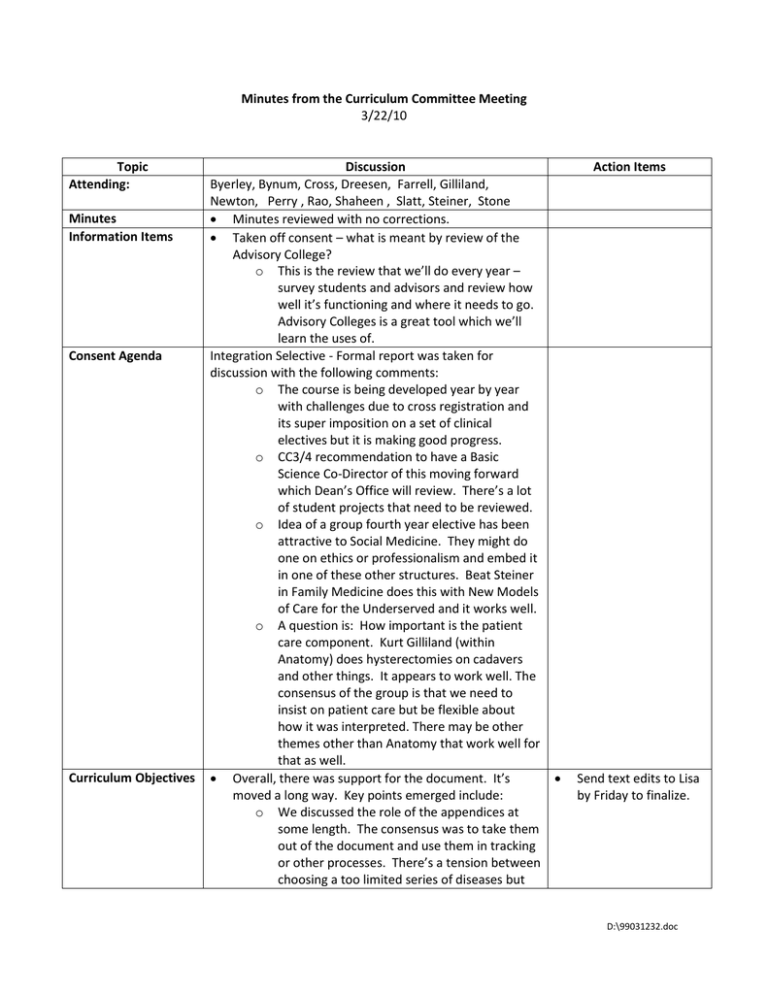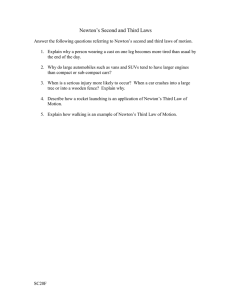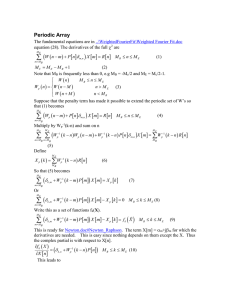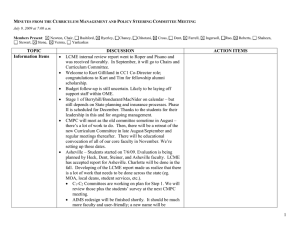3/22/10 Byerley, Bynum, Cross, Dreesen, Farrell, Gilliland,
advertisement

Minutes from the Curriculum Committee Meeting 3/22/10 Topic Attending: Minutes Information Items Consent Agenda Curriculum Objectives Discussion Byerley, Bynum, Cross, Dreesen, Farrell, Gilliland, Newton, Perry , Rao, Shaheen , Slatt, Steiner, Stone Minutes reviewed with no corrections. Taken off consent – what is meant by review of the Advisory College? o This is the review that we’ll do every year – survey students and advisors and review how well it’s functioning and where it needs to go. Advisory Colleges is a great tool which we’ll learn the uses of. Integration Selective - Formal report was taken for discussion with the following comments: o The course is being developed year by year with challenges due to cross registration and its super imposition on a set of clinical electives but it is making good progress. o CC3/4 recommendation to have a Basic Science Co-Director of this moving forward which Dean’s Office will review. There’s a lot of student projects that need to be reviewed. o Idea of a group fourth year elective has been attractive to Social Medicine. They might do one on ethics or professionalism and embed it in one of these other structures. Beat Steiner in Family Medicine does this with New Models of Care for the Underserved and it works well. o A question is: How important is the patient care component. Kurt Gilliland (within Anatomy) does hysterectomies on cadavers and other things. It appears to work well. The consensus of the group is that we need to insist on patient care but be flexible about how it was interpreted. There may be other themes other than Anatomy that work well for that as well. Overall, there was support for the document. It’s moved a long way. Key points emerged include: o We discussed the role of the appendices at some length. The consensus was to take them out of the document and use them in tracking or other processes. There’s a tension between choosing a too limited series of diseases but Action Items Send text edits to Lisa by Friday to finalize. D:\99031232.doc o o o there is also value in helping block/clerkship directors determine curriculum. What’s the best criteria for choosing conditions? It’s important to patients in NC as well as a particular interest nationally and globally. We also need to embed some element of updatability – that is we will review this on an going basis - not only the document but the list of conditions. Managing the health of the populations will require new curriculum and perhaps a new course. The next step will be vertical integration. We will try to come up with six small task forces to assess where students should be at each year for each competency. The CC leaders will nominate people; having a template will help the process. With the help of CC leaders, Newton will follow-up with charge for each task force, with goal of reviewing templates at the next meeting. o System for Quality Improvement Medical knowledge may need more people because there’s more to it and it’s difficult to sort out what is year 1 and year 2. However, these groups should not get into the specifics of particular content areas. Newton reviewed the ideas behind the “straw man” and the discussion focused on: o What’s the definition of outcomes and how should we move forward? This includes not only objective outcomes but also longer term outcomes and we will have to decide what we think are critical. o We’ve got IOM recommendations along these lines but we need to be explicit. o Perhaps this can be something that we can discuss in the strategic review. Another issue is which data would actually be available at which time. It might be that we need to sort what is May and what is September but in general people thought this was an overall process and were comfortable with a combination of “bottom up” and “top down”. What’s the purpose of mapping? To some extent, it’s just a classification of where things are taught but we don’t want to drive down into too much detail. The D:\99031232.doc ICM pillars are going to be the competencies and vertical integration should be around those instead of specific diseases. Newton reviewed the report and his follow-up discussion with students. He described a proposal for major surgery on ICM including: a) splitting the course into two groups, b) taught each by both a generalist and specialist among people who saw patients both in the inpatient and outpatient setting. The budget would be flexible within the current year. Once we define clinical skills progression – and hence know, faculty should consider many substantial changes including changes in the community week, changes in size of precepting groups and emphasis on live patients as opposed to standardized patients. Other Ideas: New Medical Education Building Affirm the importance of community medicine as a key element of the week and make better use of ICM weeks. There is real value in getting outside of Chapel Hill to different sorts of practices. Newton described the building and the planning process that is underway. He described the decision between organizing it around Advisory Colleges or expanded homerooms, a la Berryhill. There was complete consensus that we wanted to move forward with the Advisory College because of the opportunity for vertical integration moving forward. The consensus of the group was to move forward with significant change, recognizing that it would take place over multiple years. ICM faculty come up with ideas and come back made sense. Integrating it into the clinical skills vertical curriculum is also important. Newton will identify course leaders after discussion with leaders. Consensus: Recruitment for primary care is not an objective of the course. Consensus: Organized space around Advisory Colleges. D:\99031232.doc






